一、App启动涉及到的三个进程
1、Launcher进程:负责接收用户点击屏幕的事件,它其实就是一个Activity,屏幕上的各种Icon就是这个Activity中的Button,当点击Icon时,会触发启动App的流程。
2、SystemServer进程:它是属于Application Framework层的,在SystemServer中启动了非常多的服务(例如:AMS、PMS、WMS等),这些服务都交给SystemServiceManager来管理。
3、App进程:需要启动的App进程
4、Zygote进程:fork App进程的进程
二、App启动所涉及到几个大类
1、ActivityManagerService(AMS):AMS主要负责系统中四大组件的启动、切换、调度及应用进程的管理和调度等工作,它本身也是一个Binder类。
2、Instrumentation:监控应用程序和系统的交互(每个Activity都会持有一个Instrumentation引用,整个进程只会有一个Instrumentation的实例,它主要是完成对Applicaiton和Activity初始化和生命周期的工具类)
3、ActivityThread:应用程序的入口类,通过调用main方法,开启消息循环队列。
4、ApplicationThread:ApplicationThread提供Binder通讯接口,AMS则通过代理调用此App进程的本地方法。
5、ActivityManager:客户端使用的是ActivityManager类,其内部通过调用ActivityManagerNative.getDefault()得到一个ActivityManagerProxy对象,通过它与ActivityManagerService进行通信。(注:Android8.0及8.0以上系统AMS不再通过ActivityManagerNative.getDefault()获取AMS的代理对象,而是通过IActivityManager)
6、ActivityManagerProxy:AMS服务在当前进程中的代理类,负责与AMS通信。
7、ApplicationThreadProxy:ApplicaitonThread在AMS服务中的代理类,负责与ApplicationThread通信。
三、App启动流程概述
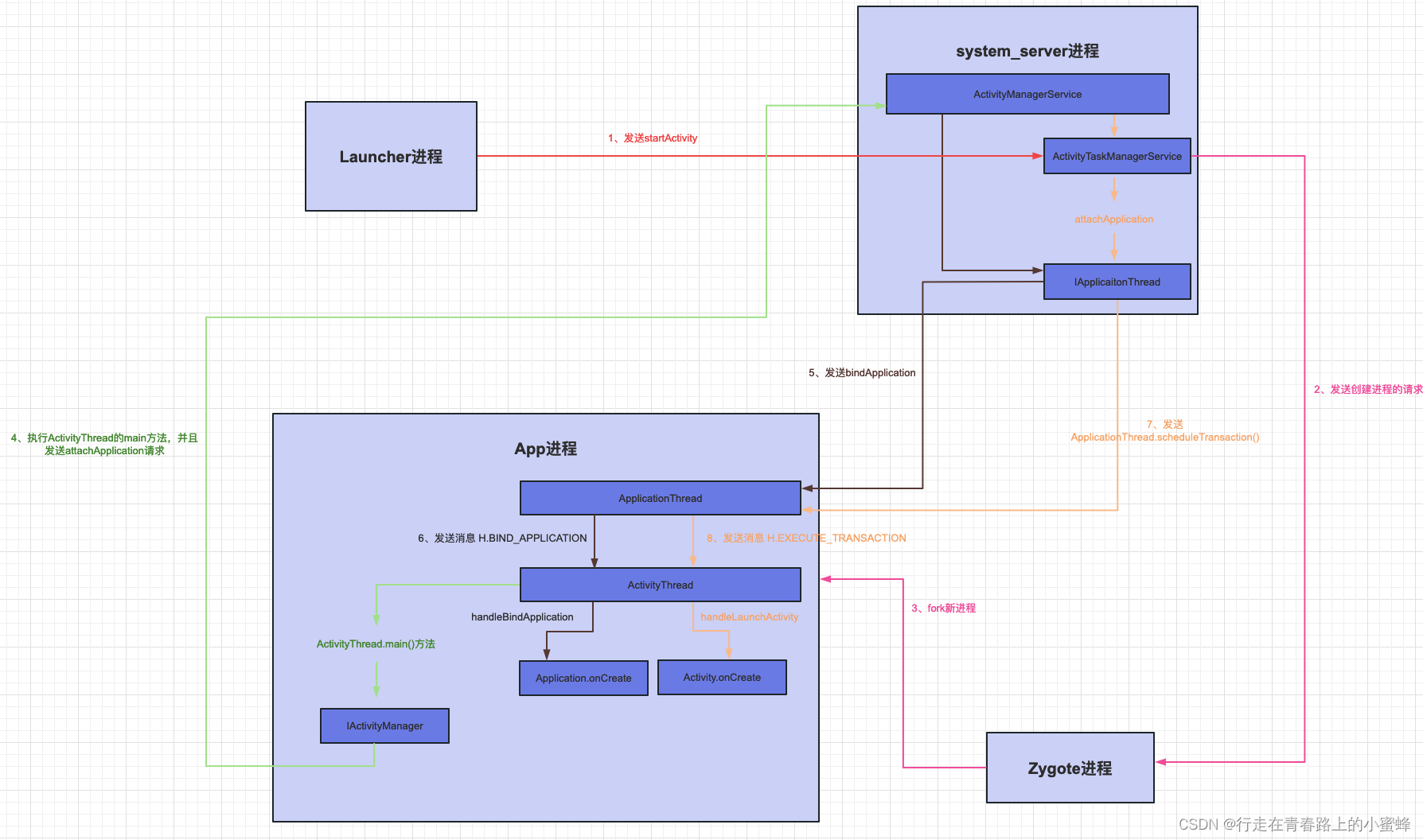 或者也可以看这个简单点的图:
或者也可以看这个简单点的图:
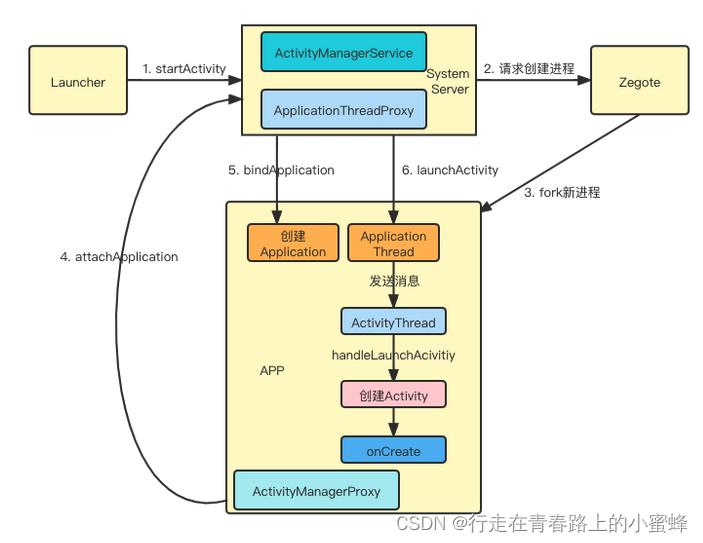
第1步:点击桌面图标,Launcher进程会采用Binder IPC(Inner-Process Communication)向system_server进程发起startActivity请求。
第2步:system_server进程接收到请求后,向zygote进程发送创建进程的请求。
第3步:Zygote进程fork出新的子进程,即App进程。
第4步:App进程创建之后,ActivityThread类的main方法会作为程序的入口执行,在ActivityThread的main方法中,会通过Binder IPC向system_server进程发起attachApplication的请求。
第5步:system_server进程在收到请求后,进行一系列的方法调用后,再通过Binder IPC向App进程发送bindApplication;
第6步:App进程的Binder线程(ApplicaitonThread)在收到bindApplication请求后,会通过Handler向主线程发送H.BIND_APPLICATION消息。在主线程收到H.BIND_APPLICATION的Handler消息后,会调用ActivityThread类中的handleBindApplication方法,完成Application的创建并回调Applicaiton.onCreate()
(注意:因为App进程与system_server进程通信是通过Binder实现的,Binder会开辟Binder线程池,那么此时这个方法的调用是在子线程中完成的,像bindApplicaiton最终需要调用Applicaiton的onCreate方法,但是这个方法是在主线程中,因此需要Handler完成线程切换)
第7步:在上述第5步的system_server进程在收到请求后,除了通过Binder IPC 向App进程发送bindApplication外,还会发送scheduleTransaction.
第8步:App进程在收到scheduleTransaction的请求后,会通过Handler向主线程发送H.EXECUTE_TRANSACTION的Handler消息。在主线程收到H.EXECUTE_TRANSACTION的Handler消息后,会调用ActivityThread类的handleLaunchActivity方法,从而完成App中起始Activity的创建并回调Activity.onCreate()
注:以上步骤中第2步,system_server进程与Zygote进程的通信 以及
第3步,Zygote进程fork出App进程 是以Socket方式 进行的通信;而Launcher进程、system_server进程、App进程间的通信是以Binder IPC方式通信的。
四、App启动流程源码剖析(该启动流程源码分析基于Android33)
关于App启动流程的分析,我们从Launcher进程开始
1、Launcher进程
首先,Launcher进程是Zygote进程fork出的一个进程,我们看到的手机桌面可以认为是Launcher进程中的一个Activity,即LauncherActivity,而桌面上的每一个Icon可以看作是这个LauncherActivity中的一个个的Button,用户点击桌面上App Icon的行为其实就是点击LauncherActivity中的Icon。
那么Launcher进程是什么时候启动的呢?
我们知道除了Launcher进程之外,还有一个很重要的进程就是SystemServer进程,而SystemServer进程是Zygote进程fork出的第一个进程,SystemServer进程在启动的过程中会启动PMS(PackageManagerService)、AMS、WMS等,PMS启动后会将系统中的应用程序安装完成,先前已经启动的AMS会将Launcher启动起来。
首先看下SystemServer进程的main方法,这里是SystemServer进程的入口函数:
public static void main(String[] args) {
new SystemServer().run();
}
而在SystemServer的run方法中,启动了很多Service服务:
private void run() {
.....
try {
t.traceBegin("StartServices");
startBootstrapServices(t);
startCoreServices(t);
startOtherServices(t);
startApexServices(t);
} catch (Throwable ex) {
Slog.e("System", "******************************************");
Slog.e("System", "************ Failure starting system services", ex);
throw ex;
} finally {
t.traceEnd(); // StartServices
}
.....
}
其中有调用startOtherServices()方法,在startOtherServices()方法中,调用了AMS的systemReady()方法,此即为Launcher的入口,如下所示:
private void startOtherServices() {
...
mActivityManagerService.systemReady(() -> {
Slog.i(TAG, "Making services ready");
traceBeginAndSlog("StartActivityManagerReadyPhase");
mSystemServiceManager.startBootPhase(
SystemService.PHASE_ACTIVITY_MANAGER_READY);
...
}
...
}
再来看下AMS的systemReady()方法:
public void systemReady(final Runnable goingCallback, TimingsTraceLog traceLog) {
...
synchronized (this) {
...
mStackSupervisor.resumeFocusedStackTopActivityLocked();
mUserController.sendUserSwitchBroadcasts(-1, currentUserId);
...
}
}
这里逻辑比较长,就不一一赘述了,只需要知道这里是Launcher的入口,最后会通过AMS把LauncherActivity启动起来,再来看下LauncherActivity:
public abstract class LauncherActivity extends ListActivity {
.....
@Override
protected void onListItemClick(ListView l, View v, int position, long id) {
Intent intent = intentForPosition(position);
startActivity(intent);
}
.....
}
可以看到LauncherActivity是继承于ListActivity的,并且有onListItemClick的回调方法,而这里的回调就是点击桌面Icon的回调,那么在收到点击桌面icon的回调后,调用了startActivity去执行启动Activity的流程了。
这里注意一下获取Intent的方法,IntentForPosition:
public Intent intentForPosition(int position) {
if (mActivitiesList == null) {
return null;
}
Intent intent = new Intent(mIntent);
ListItem item = mActivitiesList.get(position);
intent.setClassName(item.packageName, item.className);
if (item.extras != null) {
intent.putExtras(item.extras);
}
return intent;
}
再回到上面调用startActivity的地方,这里调用的是Activity#startActivity方法:
@Override
public void startActivity(Intent intent, @Nullable Bundle options) {
getAutofillClientController().onStartActivity(intent, mIntent);
if (options != null) {
startActivityForResult(intent, -1, options);
} else {
// Note we want to go through this call for compatibility with
// applications that may have overridden the method.
startActivityForResult(intent, -1);
}
}
接着,Activity#startActivity方法会调用Activity#startActivityForResult方法:
public void startActivityForResult(@RequiresPermission Intent intent, int requestCode,
@Nullable Bundle options) {
if (mParent == null) {
options = transferSpringboardActivityOptions(options);
Instrumentation.ActivityResult ar =
mInstrumentation.execStartActivity(
this, mMainThread.getApplicationThread(), mToken, this,
intent, requestCode, options);
......
}
}
注意上面重要的一行代码调用Instrumentation#execStartActivity方法:
public ActivityResult execStartActivity(
Context who, IBinder contextThread, IBinder token, Activity target,
Intent intent, int requestCode, Bundle options) {
.....
try {
intent.migrateExtraStreamToClipData(who);
intent.prepareToLeaveProcess(who);
int result = ActivityTaskManager.getService().startActivity(whoThread,
who.getOpPackageName(), who.getAttributionTag(), intent,
intent.resolveTypeIfNeeded(who.getContentResolver()), token,
target != null ? target.mEmbeddedID : null, requestCode, 0, null, options);
checkStartActivityResult(result, intent);
} catch (RemoteException e) {
throw new RuntimeException("Failure from system", e);
}
return null;
}
public static IActivityTaskManager getService() {
return IActivityTaskManagerSingleton.get();
}
//获取单例
@UnsupportedAppUsage(trackingBug = 129726065)
private static final Singleton<IActivityTaskManager> IActivityTaskManagerSingleton =
new Singleton<IActivityTaskManager>() {
@Override
protected IActivityTaskManager create() {
final IBinder b = ServiceManager.getService(Context.ACTIVITY_TASK_SERVICE);
return IActivityTaskManager.Stub.asInterface(b);
}
};
然后,在Instrumentation#execStartActivity方法中,通过ActivityTaskManager.getService()获取到ActivityTaskManagerService对象(注:这里从Launcher进程调用到了SystemServer进程中的方法,通过Binder IPC通信),然后调用ActivityTaskManagerService的startActivity方法:
@Override
public final int startActivity(IApplicationThread caller, String callingPackage,
String callingFeatureId, Intent intent, String resolvedType, IBinder resultTo,
String resultWho, int requestCode, int startFlags, ProfilerInfo profilerInfo,
Bundle bOptions) {
return startActivityAsUser(caller, callingPackage, callingFeatureId, intent, resolvedType,
resultTo, resultWho, requestCode, startFlags, profilerInfo, bOptions,
UserHandle.getCallingUserId());
}
然后调用ActivityTaskManagerService#startActivity方法又调用了然后调用ActivityTaskManagerService的startActivityAsUser方法:
private int startActivityAsUser(IApplicationThread caller, String callingPackage,
@Nullable String callingFeatureId, Intent intent, String resolvedType,
IBinder resultTo, String resultWho, int requestCode, int startFlags,
ProfilerInfo profilerInfo, Bundle bOptions, int userId, boolean validateIncomingUser) {
.....
return getActivityStartController().obtainStarter(intent, "startActivityAsUser")
.setCaller(caller)
.setCallingPackage(callingPackage)
.setCallingFeatureId(callingFeatureId)
.setResolvedType(resolvedType)
.setResultTo(resultTo)
.setResultWho(resultWho)
.setRequestCode(requestCode)
.setStartFlags(startFlags)
.setProfilerInfo(profilerInfo)
.setActivityOptions(bOptions)
.setUserId(userId)
.execute();
}
由上面代码可以看出这里通过getActivityStartController()得到ActivityStarter,并且调用ActivityStarter#obtainStarter方法:
ActivityStarter obtainStarter(Intent intent, String reason) {
return mFactory.obtain().setIntent(intent).setReason(reason);
}
再看ActivityStarter的execute方法:
int execute() {
try {
...
res = executeRequest(mRequest);
} finally {
onExecutionComplete();
}
}
private int executeRequest(Request request) {
...
//各种权限检查
boolean abort = !mSupervisor.checkStartAnyActivityPermission(intent, aInfo, resultWho,
requestCode, callingPid, callingUid, callingPackage, callingFeatureId,
request.ignoreTargetSecurity, inTask != null, callerApp, resultRecord,
resultRootTask);
abort |= !mService.mIntentFirewall.checkStartActivity(intent, callingUid,
callingPid, resolvedType, aInfo.applicationInfo);
abort |= !mService.getPermissionPolicyInternal().checkStartActivity(intent, callingUid,
callingPackage);
...
mLastStartActivityResult = startActivityUnchecked(r, sourceRecord, voiceSession,
request.voiceInteractor, startFlags, true /* doResume */, checkedOptions, inTask,
restrictedBgActivity, intentGrants);
if (request.outActivity != null) {
request.outActivity[0] = mLastStartActivityRecord;
}
return mLastStartActivityResult;
}
private int startActivityUnchecked(final ActivityRecord r, ActivityRecord sourceRecord,
IVoiceInteractionSession voiceSession, IVoiceInteractor voiceInteractor,
int startFlags, boolean doResume, ActivityOptions options, Task inTask,
boolean restrictedBgActivity, NeededUriGrants intentGrants) {
...
try {
mService.deferWindowLayout();
Trace.traceBegin(Trace.TRACE_TAG_WINDOW_MANAGER, "startActivityInner");
result = startActivityInner(r, sourceRecord, voiceSession, voiceInteractor,
startFlags, doResume, options, inTask, restrictedBgActivity, intentGrants);
} finally {
....
}
...
return result;
}
int startActivityInner(final ActivityRecord r, ActivityRecord sourceRecord,
IVoiceInteractionSession voiceSession, IVoiceInteractor voiceInteractor,
int startFlags, boolean doResume, ActivityOptions options, Task inTask,
boolean restrictedBgActivity, NeededUriGrants intentGrants) {
setInitialState(r, options, inTask, doResume, startFlags, sourceRecord, voiceSession,
voiceInteractor, restrictedBgActivity);
...
if (mDoResume) {//mDoResume=true
final ActivityRecord topTaskActivity =
mStartActivity.getTask().topRunningActivityLocked();
if (!mTargetRootTask.isTopActivityFocusable()
|| (topTaskActivity != null && topTaskActivity.isTaskOverlay()
&& mStartActivity != topTaskActivity)) {//此处false
// If the activity is not focusable, we can't resume it, but still would like to
// make sure it becomes visible as it starts (this will also trigger entry
// animation). An example of this are PIP activities.
// Also, we don't want to resume activities in a task that currently has an overlay
// as the starting activity just needs to be in the visible paused state until the
// over is removed.
// Passing {@code null} as the start parameter ensures all activities are made
// visible.
mTargetRootTask.ensureActivitiesVisible(null /* starting */,
0 /* configChanges */, !PRESERVE_WINDOWS);
// Go ahead and tell window manager to execute app transition for this activity
// since the app transition will not be triggered through the resume channel.
mTargetRootTask.mDisplayContent.executeAppTransition();
} else {
// If the target root-task was not previously focusable (previous top running
// activity on that root-task was not visible) then any prior calls to move the
// root-task to the will not update the focused root-task. If starting the new
// activity now allows the task root-task to be focusable, then ensure that we
// now update the focused root-task accordingly.
if (mTargetRootTask.isTopActivityFocusable()
&& !mRootWindowContainer.isTopDisplayFocusedRootTask(mTargetRootTask)) {
mTargetRootTask.moveToFront("startActivityInner");
}
mRootWindowContainer.resumeFocusedTasksTopActivities(
mTargetRootTask, mStartActivity, mOptions, mTransientLaunch);
}
}
...
return START_SUCCESS;
}
最终调用了RootWindowContainer的resumeFocusedTasksTopActivities方法:
boolean resumeFocusedTasksTopActivities(
Task targetRootTask, ActivityRecord target, ActivityOptions targetOptions,
boolean deferPause) {
...
final Task focusedRoot = display.getFocusedRootTask();
if (focusedRoot != null) {
result |= focusedRoot.resumeTopActivityUncheckedLocked(target, targetOptions);
} else if (targetRootTask == null) {
result |= resumeHomeActivity(null /* prev */, "no-focusable-task",
display.getDefaultTaskDisplayArea());
}
return result;
}
RootWindowContainer:根部WindowContainer,一切WindowContainer的管理者。
然后调用了Taks.resumeTopActivityUnCheckedLocked方法:
boolean resumeTopActivityUncheckedLocked(ActivityRecord prev, ActivityOptions options) {
return resumeTopActivityUncheckedLocked(prev, options, false /* skipPause */);
}
boolean resumeTopActivityUncheckedLocked(ActivityRecord prev, ActivityOptions options,
boolean deferPause) {
...
if (isFocusableAndVisible()) {
someActivityResumed = resumeTopActivityInnerLocked(prev, options, deferPause);
}
return someActivityResumed;
}
private boolean resumeTopActivityInnerLocked(ActivityRecord prev, ActivityOptions options,
boolean deferPause) {
//调用最上层activity onPause方法
if (mResumedActivity != null) {
ProtoLog.d(WM_DEBUG_STATES, "resumeTopActivityLocked: Pausing %s", mResumedActivity);
pausing |= startPausingLocked(false /* uiSleeping */, next,
"resumeTopActivityInnerLocked");
}
..
if (next.attachedToProcess()) {
...
}else{
mTaskSupervisor.startSpecificActivity(next, true, true);
}
return true;
}
紧接着调用了ActivityTaskSupervisor.startSpecificActivity方法:
void startSpecificActivity(ActivityRecord r, boolean andResume, boolean checkConfig) {
......
// Create activity launch transaction.
final ClientTransaction clientTransaction = ClientTransaction.obtain(
proc.getThread(), r.token);
final boolean isTransitionForward = r.isTransitionForward();
final IBinder fragmentToken = r.getTaskFragment().getFragmentToken();
clientTransaction.addCallback(LaunchActivityItem.obtain(new Intent(r.intent),
System.identityHashCode(r), r.info,
// TODO: Have this take the merged configuration instead of separate global
// and override configs.
mergedConfiguration.getGlobalConfiguration(),
mergedConfiguration.getOverrideConfiguration(), r.compat,
r.getFilteredReferrer(r.launchedFromPackage), task.voiceInteractor,
proc.getReportedProcState(), r.getSavedState(), r.getPersistentSavedState(),
results, newIntents, r.takeOptions(), isTransitionForward,
proc.createProfilerInfoIfNeeded(), r.assistToken, activityClientController,
r.shareableActivityToken, r.getLaunchedFromBubble(), fragmentToken));
// Set desired final state.
final ActivityLifecycleItem lifecycleItem;
if (andResume) {
lifecycleItem = ResumeActivityItem.obtain(isTransitionForward);
} else {
lifecycleItem = PauseActivityItem.obtain();
}
clientTransaction.setLifecycleStateRequest(lifecycleItem);
// Schedule transaction.
mService.getLifecycleManager().scheduleTransaction(clientTransaction);
if (procConfig.seq > mRootWindowContainer.getConfiguration().seq) {
// If the seq is increased, there should be something changed (e.g. registered
// activity configuration).
proc.setLastReportedConfiguration(procConfig);
}
if ((proc.mInfo.privateFlags & ApplicationInfo.PRIVATE_FLAG_CANT_SAVE_STATE) != 0
&& mService.mHasHeavyWeightFeature) {
// This may be a heavy-weight process! Note that the package manager will ensure
// that only activity can run in the main process of the .apk, which is the only
// thing that will be considered heavy-weight.
if (proc.mName.equals(proc.mInfo.packageName)) {
if (mService.mHeavyWeightProcess != null
&& mService.mHeavyWeightProcess != proc) {
Slog.w(TAG, "Starting new heavy weight process " + proc
+ " when already running "
+ mService.mHeavyWeightProcess);
}
mService.setHeavyWeightProcess(r);
}
}
} catch (RemoteException e) {
if (r.launchFailed) {
// This is the second time we failed -- finish activity and give up.
Slog.e(TAG, "Second failure launching "
+ r.intent.getComponent().flattenToShortString() + ", giving up", e);
proc.appDied("2nd-crash");
r.finishIfPossible("2nd-crash", false /* oomAdj */);
return false;
}
// This is the first time we failed -- restart process and
// retry.
r.launchFailed = true;
r.detachFromProcess();
throw e;
}
} finally {
endDeferResume();
proc.resumeConfigurationDispatch();
}
.......
return true;
}
这里面重点关注下这行代码(这里会最终调用到ApplicationThread的scheduleTransaction方法,这个在App启动流程分析(二)中有讲到):
mService.getLifecycleManager().scheduleTransaction(clientTransaction);
ActivityTaskManagerService.startProcessAsync方法中发送了一个消息,最终执行了ActivityManagerService.startProcess:
public void startProcess(String processName, ApplicationInfo info, boolean knownToBeDead,
boolean isTop, String hostingType, ComponentName hostingName) {
try {
if (Trace.isTagEnabled(Trace.TRACE_TAG_ACTIVITY_MANAGER)) {
Trace.traceBegin(Trace.TRACE_TAG_ACTIVITY_MANAGER, "startProcess:"
+ processName);
}
synchronized (ActivityManagerService.this) {
// If the process is known as top app, set a hint so when the process is
// started, the top priority can be applied immediately to avoid cpu being
// preempted by other processes before attaching the process of top app.
startProcessLocked(processName, info, knownToBeDead, 0 /* intentFlags */,
new HostingRecord(hostingType, hostingName, isTop),
ZYGOTE_POLICY_FLAG_LATENCY_SENSITIVE, false /* allowWhileBooting */,
false /* isolated */);
}
} finally {
Trace.traceEnd(Trace.TRACE_TAG_ACTIVITY_MANAGER);
}
}
ProcessList.startProcessLocked:
final ProcessRecord startProcessLocked(String processName,
ApplicationInfo info, boolean knownToBeDead, int intentFlags,
HostingRecord hostingRecord, int zygotePolicyFlags, boolean allowWhileBooting,
boolean isolated) {
return mProcessList.startProcessLocked(processName, info, knownToBeDead, intentFlags,
hostingRecord, zygotePolicyFlags, allowWhileBooting, isolated, 0 /* isolatedUid */,
null /* ABI override */, null /* entryPoint */,
null /* entryPointArgs */, null /* crashHandler */);
}
ProcessRecord startProcessLocked(String processName, ApplicationInfo info,
boolean knownToBeDead, int intentFlags, HostingRecord hostingRecord,
int zygotePolicyFlags, boolean allowWhileBooting, boolean isolated, int isolatedUid,
String abiOverride, String entryPoint, String[] entryPointArgs, Runnable crashHandler) {
...
checkSlow(startTime, "startProcess: stepping in to startProcess");
final boolean success =
startProcessLocked(app, hostingRecord, zygotePolicyFlags, abiOverride);
checkSlow(startTime, "startProcess: done starting proc!");
return success ? app : null;
}
boolean startProcessLocked(ProcessRecord app, HostingRecord hostingRecord,
int zygotePolicyFlags, String abiOverride) {
return startProcessLocked(app, hostingRecord, zygotePolicyFlags,
false /* disableHiddenApiChecks */, false /* disableTestApiChecks */,
abiOverride);
}
boolean startProcessLocked(ProcessRecord app, HostingRecord hostingRecord,
int zygotePolicyFlags, boolean disableHiddenApiChecks, boolean disableTestApiChecks,
String abiOverride) {
...
try {
...
//记住这里的entryPoint属性,进程启动后会用到
final String entryPoint = "android.app.ActivityThread";
return startProcessLocked(hostingRecord, entryPoint, app, uid, gids,
runtimeFlags, zygotePolicyFlags, mountExternal, seInfo, requiredAbi,
instructionSet, invokeWith, startTime);
} catch (RuntimeException e) {
return false;
}
}
@GuardedBy("mService")
boolean startProcessLocked(HostingRecord hostingRecord, String entryPoint, ProcessRecord app,
int uid, int[] gids, int runtimeFlags, int zygotePolicyFlags, int mountExternal,
String seInfo, String requiredAbi, String instructionSet, String invokeWith,
long startTime) {
...
final Process.ProcessStartResult startResult = startProcess(hostingRecord,
entryPoint, app,
uid, gids, runtimeFlags, zygotePolicyFlags, mountExternal, seInfo,
requiredAbi, instructionSet, invokeWith, startTime);
handleProcessStartedLocked(app, startResult.pid, startResult.usingWrapper,
startSeq, false);
return app.getPid() > 0;
}
}
private Process.ProcessStartResult startProcess(HostingRecord hostingRecord, String entryPoint,
ProcessRecord app, int uid, int[] gids, int runtimeFlags, int zygotePolicyFlags,
int mountExternal, String seInfo, String requiredAbi, String instructionSet,
String invokeWith, long startTime) {
try {
...
if (hostingRecord.usesWebviewZygote()) {
startResult = startWebView(entryPoint,
app.processName, uid, uid, gids, runtimeFlags, mountExternal,
app.info.targetSdkVersion, seInfo, requiredAbi, instructionSet,
app.info.dataDir, null, app.info.packageName,
app.getDisabledCompatChanges(),
new String[]{PROC_START_SEQ_IDENT + app.getStartSeq()});
} else if (hostingRecord.usesAppZygote()) {
//普通应用会进入这里
//创建zygote对象
final AppZygote appZygote = createAppZygoteForProcessIfNeeded(app);
// 使用Socket通知zygote对象
startResult = appZygote.getProcess().start(entryPoint,
app.processName, uid, uid, gids, runtimeFlags, mountExternal,
app.info.targetSdkVersion, seInfo, requiredAbi, instructionSet,
app.info.dataDir, null, app.info.packageName,
/*zygotePolicyFlags=*/ ZYGOTE_POLICY_FLAG_EMPTY, isTopApp,
app.getDisabledCompatChanges(), pkgDataInfoMap, allowlistedAppDataInfoMap,
false, false,
new String[]{PROC_START_SEQ_IDENT + app.getStartSeq()});
} else {
regularZygote = true;
startResult = Process.start(entryPoint,
app.processName, uid, uid, gids, runtimeFlags, mountExternal,
app.info.targetSdkVersion, seInfo, requiredAbi, instructionSet,
app.info.dataDir, invokeWith, app.info.packageName, zygotePolicyFlags,
isTopApp, app.getDisabledCompatChanges(), pkgDataInfoMap,
allowlistedAppDataInfoMap, bindMountAppsData, bindMountAppStorageDirs,
new String[]{PROC_START_SEQ_IDENT + app.getStartSeq()});
}
if (!regularZygote) {
// webview and app zygote don't have the permission to create the nodes
if (Process.createProcessGroup(uid, startResult.pid) < 0) {
Slog.e(ActivityManagerService.TAG, "Unable to create process group for "
+ app.processName + " (" + startResult.pid + ")");
}
}
// This runs after Process.start() as this method may block app process starting time
// if dir is not cached. Running this method after Process.start() can make it
// cache the dir asynchronously, so zygote can use it without waiting for it.
if (bindMountAppStorageDirs) {
storageManagerInternal.prepareStorageDirs(userId, pkgDataInfoMap.keySet(),
app.processName);
}
checkSlow(startTime, "startProcess: returned from zygote!");
return startResult;
} finally {
Trace.traceEnd(Trace.TRACE_TAG_ACTIVITY_MANAGER);
}
}
ZygoteProcess.start:
public final Process.ProcessStartResult start(@NonNull final String processClass,
final String niceName,
int uid, int gid, @Nullable int[] gids,
int runtimeFlags, int mountExternal,
int targetSdkVersion,
@Nullable String seInfo,
@NonNull String abi,
@Nullable String instructionSet,
@Nullable String appDataDir,
@Nullable String invokeWith,
@Nullable String packageName,
int zygotePolicyFlags,
boolean isTopApp,
@Nullable long[] disabledCompatChanges,
@Nullable Map<String, Pair<String, Long>>
pkgDataInfoMap,
@Nullable Map<String, Pair<String, Long>>
allowlistedDataInfoList,
boolean bindMountAppsData,
boolean bindMountAppStorageDirs,
@Nullable String[] zygoteArgs) {
// TODO (chriswailes): Is there a better place to check this value?
if (fetchUsapPoolEnabledPropWithMinInterval()) {
informZygotesOfUsapPoolStatus();
}
try {
return startViaZygote(processClass, niceName, uid, gid, gids,
runtimeFlags, mountExternal, targetSdkVersion, seInfo,
abi, instructionSet, appDataDir, invokeWith, /*startChildZygote=*/ false,
packageName, zygotePolicyFlags, isTopApp, disabledCompatChanges,
pkgDataInfoMap, allowlistedDataInfoList, bindMountAppsData,
bindMountAppStorageDirs, zygoteArgs);
} catch (ZygoteStartFailedEx ex) {
Log.e(LOG_TAG,
"Starting VM process through Zygote failed");
throw new RuntimeException(
"Starting VM process through Zygote failed", ex);
}
}
private Process.ProcessStartResult startViaZygote(@NonNull final String processClass,
@Nullable final String niceName,
final int uid, final int gid,
@Nullable final int[] gids,
int runtimeFlags, int mountExternal,
int targetSdkVersion,
@Nullable String seInfo,
@NonNull String abi,
@Nullable String instructionSet,
@Nullable String appDataDir,
@Nullable String invokeWith,
boolean startChildZygote,
@Nullable String packageName,
int zygotePolicyFlags,
boolean isTopApp,
@Nullable long[] disabledCompatChanges,
@Nullable Map<String, Pair<String, Long>>
pkgDataInfoMap,
@Nullable Map<String, Pair<String, Long>>
allowlistedDataInfoList,
boolean bindMountAppsData,
boolean bindMountAppStorageDirs,
@Nullable String[] extraArgs)
throws ZygoteStartFailedEx {
...
//添加参数,这里的processClass为“android.app.ActivityThread”
argsForZygote.add(processClass);
synchronized(mLock) {
//openZygoteSocketIfNeeded会链接Socket并返回状态
return zygoteSendArgsAndGetResult(openZygoteSocketIfNeeded(abi),
zygotePolicyFlags,
argsForZygote);
}
}
private Process.ProcessStartResult zygoteSendArgsAndGetResult(
ZygoteState zygoteState, int zygotePolicyFlags, @NonNull ArrayList<String> args)
throws ZygoteStartFailedEx {
...
//输入参数拼接成msg
String msgStr = args.size() + "\n" + String.join("\n", args) + "\n";
return attemptZygoteSendArgsAndGetResult(zygoteState, msgStr);
}
private Process.ProcessStartResult attemptZygoteSendArgsAndGetResult(
ZygoteState zygoteState, String msgStr) throws ZygoteStartFailedEx {
try {
//通过状态获取输出
final BufferedWriter zygoteWriter = zygoteState.mZygoteOutputWriter;
//获取输入
final DataInputStream zygoteInputStream = zygoteState.mZygoteInputStream;
//写入参数
zygoteWriter.write(msgStr);
zygoteWriter.flush();
// Always read the entire result from the input stream to avoid leaving
// bytes in the stream for future process starts to accidentally stumble
// upon.
Process.ProcessStartResult result = new Process.ProcessStartResult();
result.pid = zygoteInputStream.readInt();
result.usingWrapper = zygoteInputStream.readBoolean();
if (result.pid < 0) {
throw new ZygoteStartFailedEx("fork() failed");
}
return result;
} catch (IOException ex) {
zygoteState.close();
Log.e(LOG_TAG, "IO Exception while communicating with Zygote - "
+ ex.toString());
throw new ZygoteStartFailedEx(ex);
}
}
这里通过Socket请求Zygote进程启动App进程,然后会等待Zygote进程的处理结果。
Zygote进程在启动的时候就会创建DVM或者ART,因此通过fork而创建的进程可以在内部获取一个DVM或者ART的实例副本。Zygote进程启动的时候会执行ZygoteInit#main方法。
先写到这里,后面关于Zygote进程fork出App进程后的后续流程在下一篇再论述。
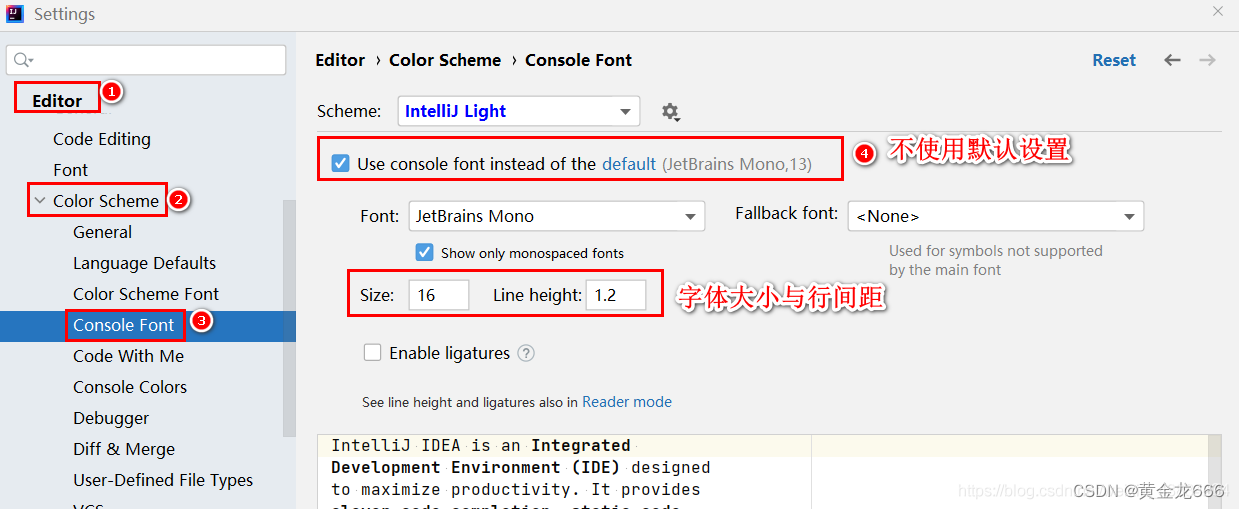
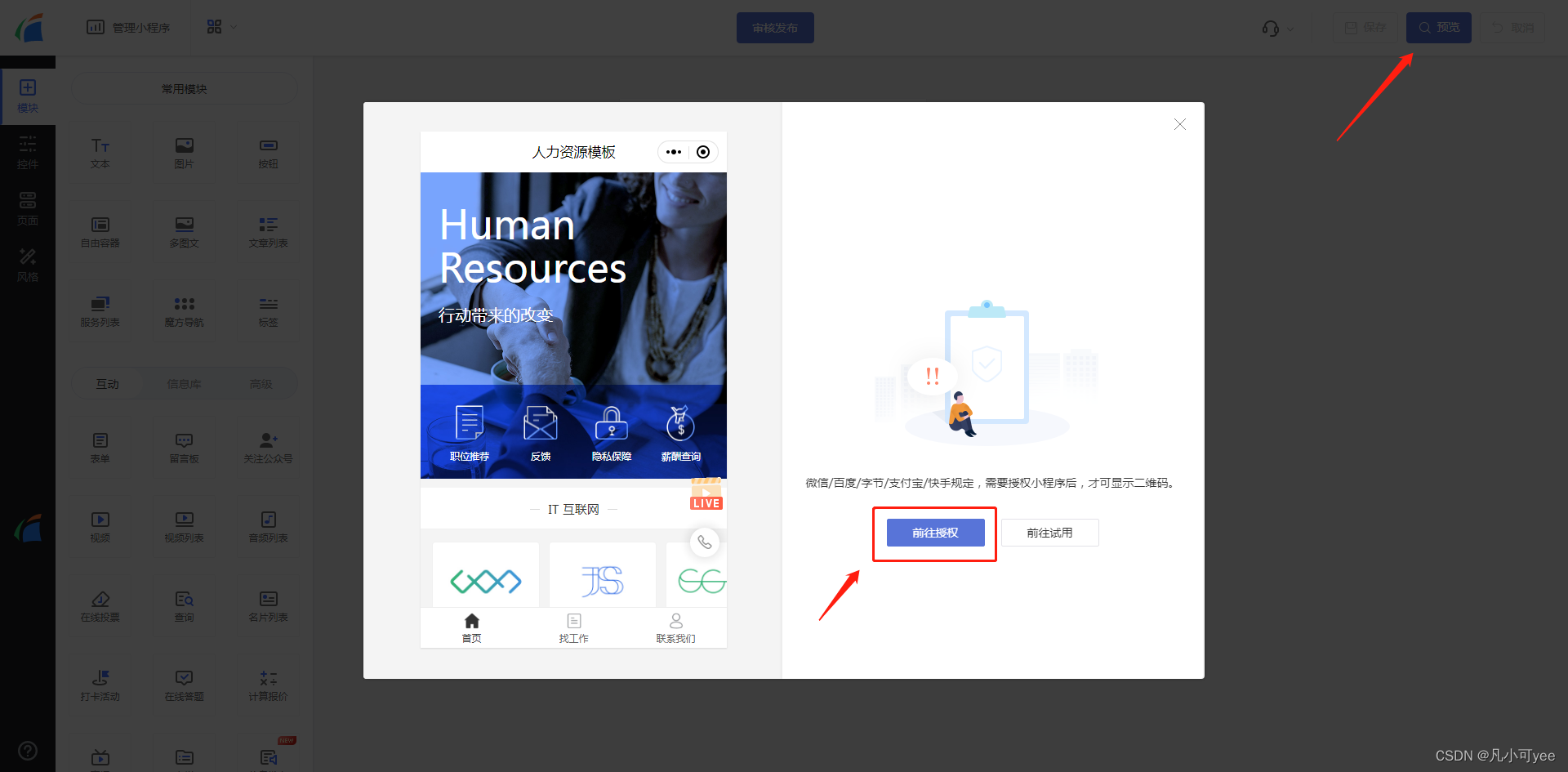


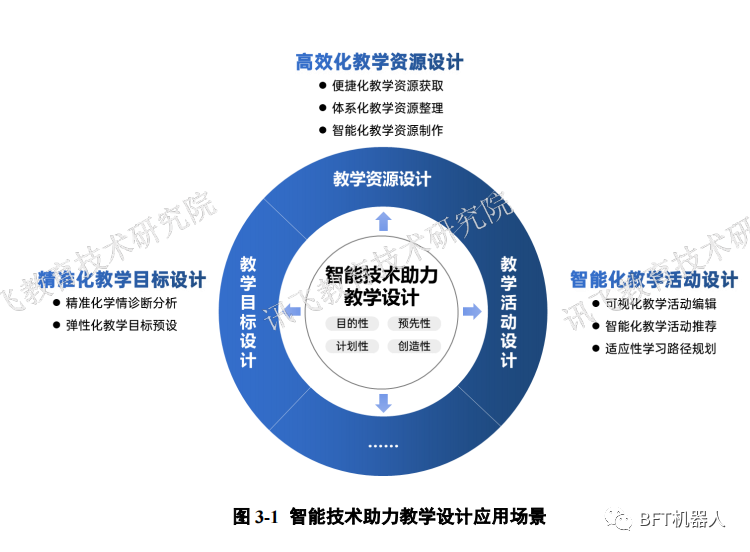
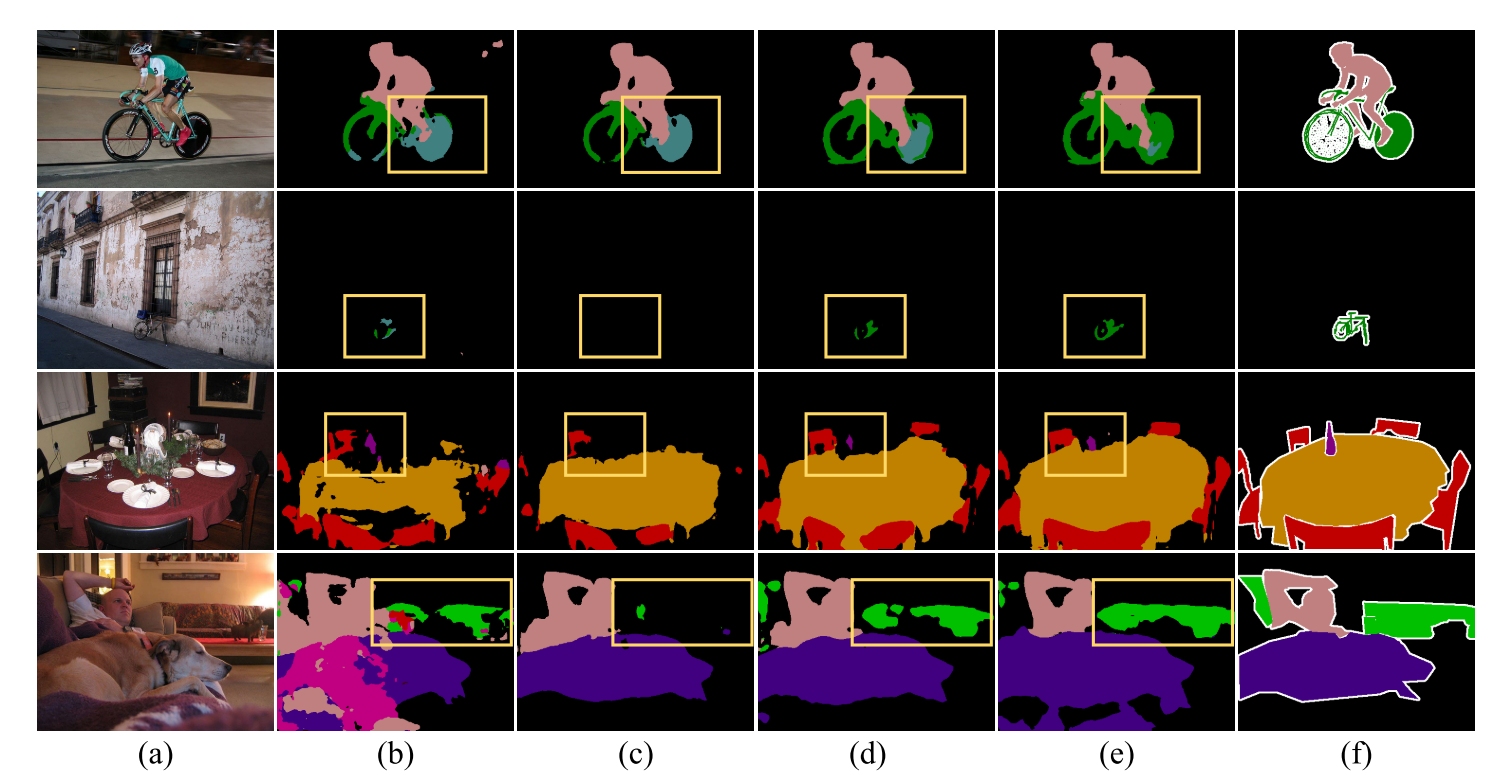
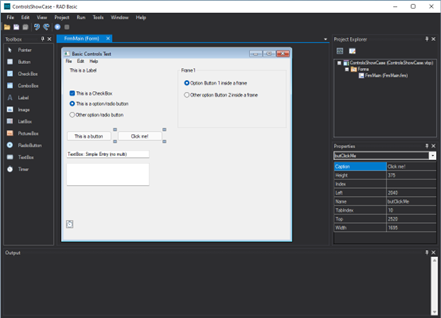
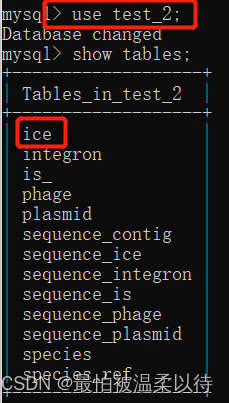



![强化学习从基础到进阶-常见问题和面试必知必答[7]:深度确定性策略梯度DDPG算法、双延迟深度确定性策略梯度TD3算法详解](https://img-blog.csdnimg.cn/d553c7dadca54bdb82a3a234befb74d8.png#pic_center)
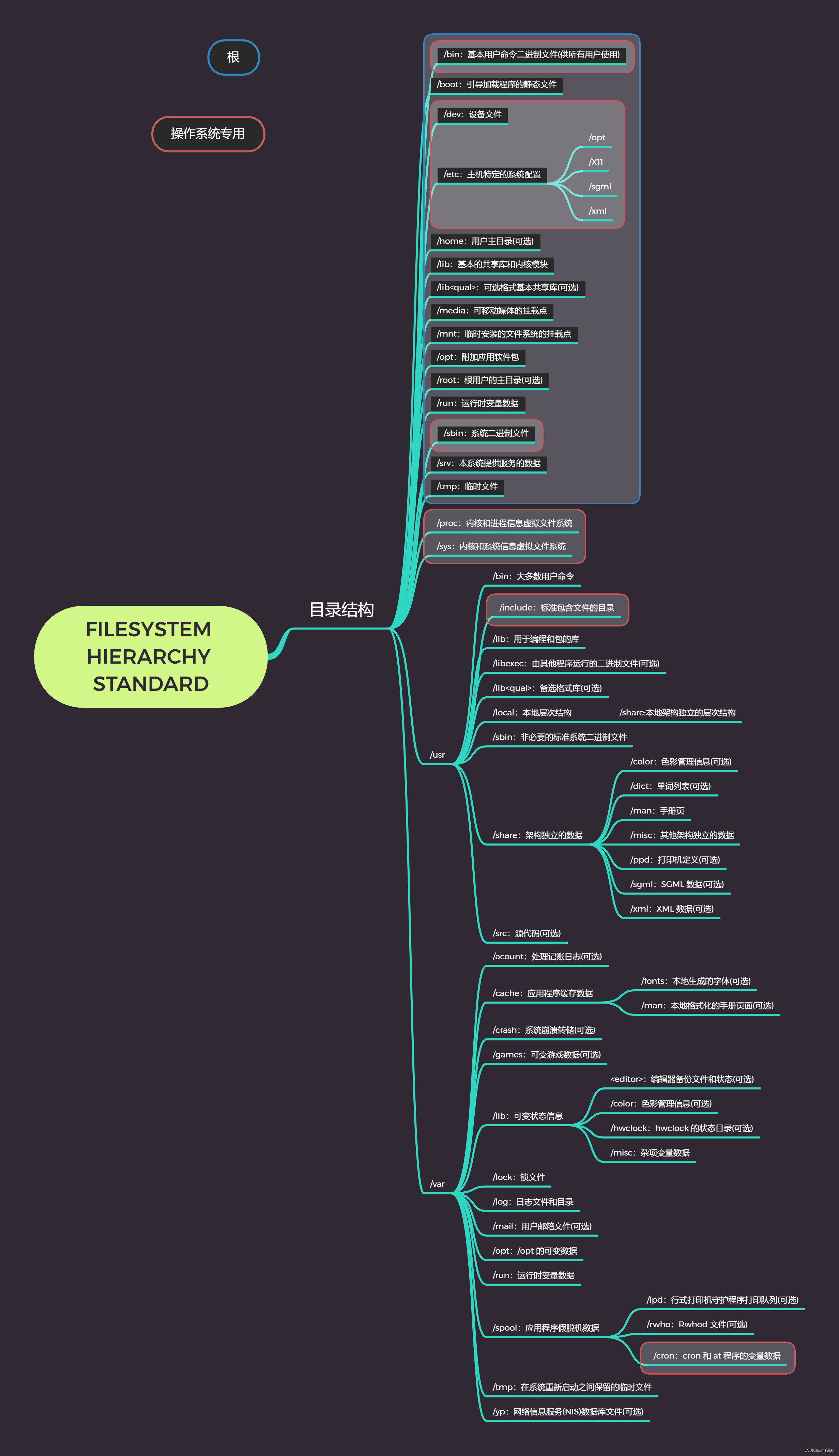
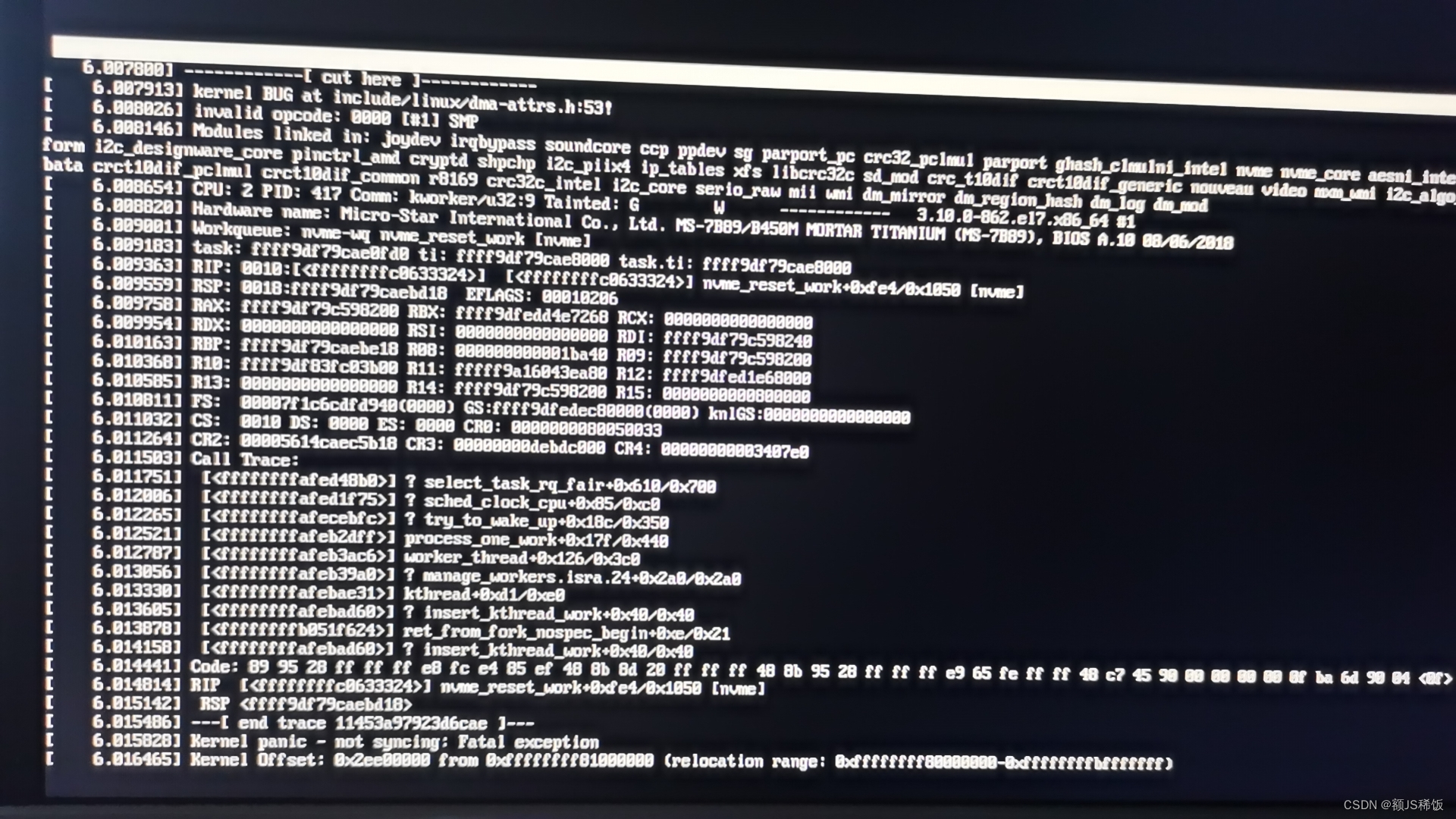




![[C++] 刷题日记](https://img-blog.csdnimg.cn/863681a16bf9432398264c5c22beeafb.png)